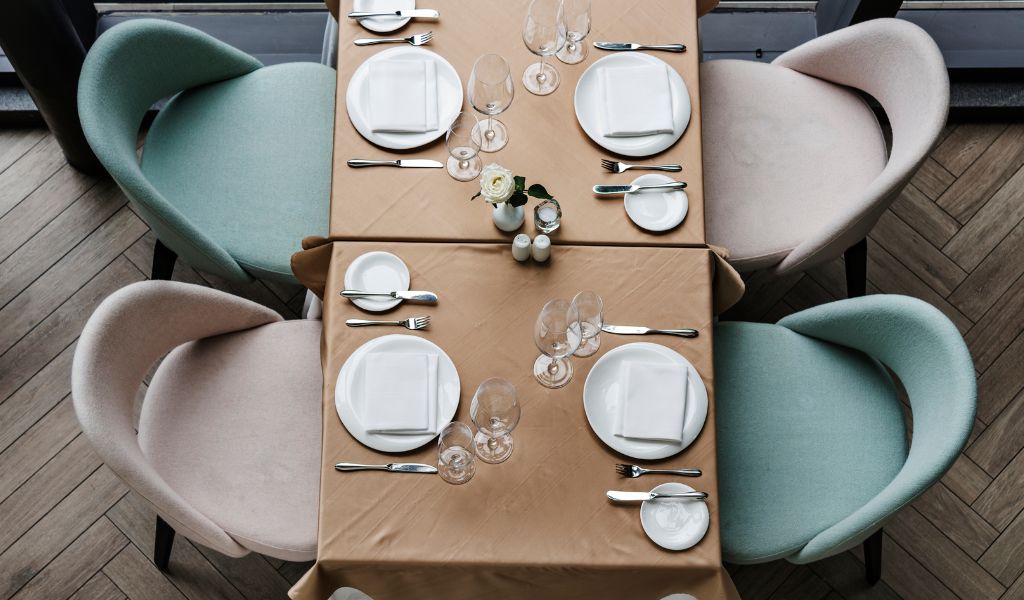Transform Your Dining Experience with Stylish Restaurant Tables
15 July 2025
5 Mins Read

toc impalement
Restaurant furnitures plays an important role in creating an inviting and comfortable atmosphere. The choice of furniture or stylish restaurant tables can improve customer satisfaction and enhance their overall dining experience.
If you are planning to open a restaurant or renovate your existing one, choosing the right kind of table is an important part if you want to set the right tone and make sure your audience gets an amazing dining experience.
Restaurant furnitures can equip owners and managers to make informed decisions to improve their dining space.
How Stylish Restaurant Tables Influence Ambiance And Guest Perception?
So, picture this—you walk into a restaurant, and without even thinking about it, your eyes go straight to the tables. Not the menu, not the staff. The tables. Weird? Not really. It’s kind of like meeting someone and noticing their shoes. Tables just… set the vibe.
If the place has chunky wooden tables with scuff marks and stories, you’re probably thinking cozy, maybe even a bit nostalgic. But if it’s all shiny glass and chrome? Instantly feels more upscale. More polished. It’s like the tables are giving off clues before you even sit down.
The shape matters too. Round tables? More chatty. Everyone sees everyone. Long ones, though—they’re kinda social but more about shared space. Anyway, the point is, tables are doing more than just holding your dinner—they’re setting the whole tone.
1. Choosing The Right Designs To Match Your Restaurant Theme
Okay, here’s where people sometimes mess up—grabbing tables just because they “look cool” without asking if they fit. Like, you wouldn’t throw marble-top tables into a beach shack and expect it to make sense, right?
Your theme kinda whispers what the tables should be. Rustic place? Go for rough wood. Sleek city vibe? Maybe matte black metal or something minimalist. But don’t just chase looks. These tables need to survive scratches, spills, kids banging silverware… all of it.
Think about how it all ties in—color, texture, even height. If your tables and your walls and your lighting all tell the same story, people feel it. They might not even realize why, but they’ll feel like it just works.
2. Blending Comfort And Style In Modern Restaurant Tables
Let’s be real—no one wants to eat a whole meal at a table that’s either too tall or too cramped. It’s awkward. Kinda ruins the vibe, no matter how pretty the table looks.
Good design isn’t just about “Instagrammable” stuff. It’s about how it feels to sit there. Rounded corners so knees aren’t getting bashed. Solid legs so nothing wobbles mid-toast. A surface that doesn’t feel sticky two seconds after being wiped.
And chairs matter here, too. Like, if the chair’s too low, it throws everything off. Have you ever sat down and felt like a toddler at Thanksgiving? Yeah, not fun. Comfort and style need to actually get along, not fight each other.
3. Using Restaurant Tables To Enhance Space And Functionality
Here’s something people forget—tables aren’t just static furniture. They can totally change how your space works.
If your place is tight on room (and honestly, most are), you’ve gotta get clever. Square tables in corners. Round ones in the middle to keep things from looking like a grid. It’s like furniture Tetris, but more stressful.
Some folks go for foldable or mobile tables now, which—honestly—is a smart move. You can switch things up depending on whether it’s a regular night or you’ve got a big group booking. Flexibility’s kind of the name of the game these days.
And spacing? Please leave room between tables. Nothing kills the mood faster than bumping elbows with strangers or having your server do the sideways shuffle every time they walk by.
How Does It Impact Business Growth?
Stylish restaurant tables have a way of impacting business growth while enhancing the experience. Here is how it affects your business.
1. Improved Customer Experience
A visually appealing, well-organized space provides a positive dining experience. This encourages them to come back and provide positive word-of-mouth recommendations.
2. Increased revenue
When a customer is satisfied, it will encourage them to spend more. The right table will directly impact sales to promote longer stays and bring a larger set of clients.
3. Operational efficiency
Good quality and well-designed tables, along with other furnitures, help the operations work out smoothly. Moreover, it improves staff productivity and the overall efficiency of the restaurant.
4. Improved Brand Image
When you use furnitures that aligns with the entire decor and image of the brand, it contributes to your professional brand identity and improves customer trust and loyalty.
Things You Should Consider While Choosing The Furnitures
When you are choosing a table or any other furniture for your business, you have to consider a few things:
- Comfort: You have to think of furnitures that will be comfortable for the customers. This will promote longer stays, and they will come back again to your restaurant.
- Durability: Restaurant furnitures will be cleaned frequently and will be heavily used. So, you have to make sure that the materials and constructions are of high quality.
- Functionality: You have to ensure that you are using a table that is practical and easy to maintain.
- Aesthetics: You have to check that these tables match the branding and decor of the restaurant.
- Budget: You have to balance the quality and cost of the furniture to make sure of long-term value.
Choose Your Furnitures Carefully
At the end of the day, a table’s not just a table. Not in a restaurant, anyway.
Stylish restaurant tables are the first thing people see. It’s where they laugh, spill wine, have awkward first dates, or celebrate birthdays. The right table says something without saying anything.
So if you’re opening a spot, or just giving yours a facelift, don’t just grab whatever’s on sale. Think it through. How it looks, how it feels, how it fits your space—every little bit matters more than you think.
And yeah, in this business, those little things? They’re usually the big things.

















